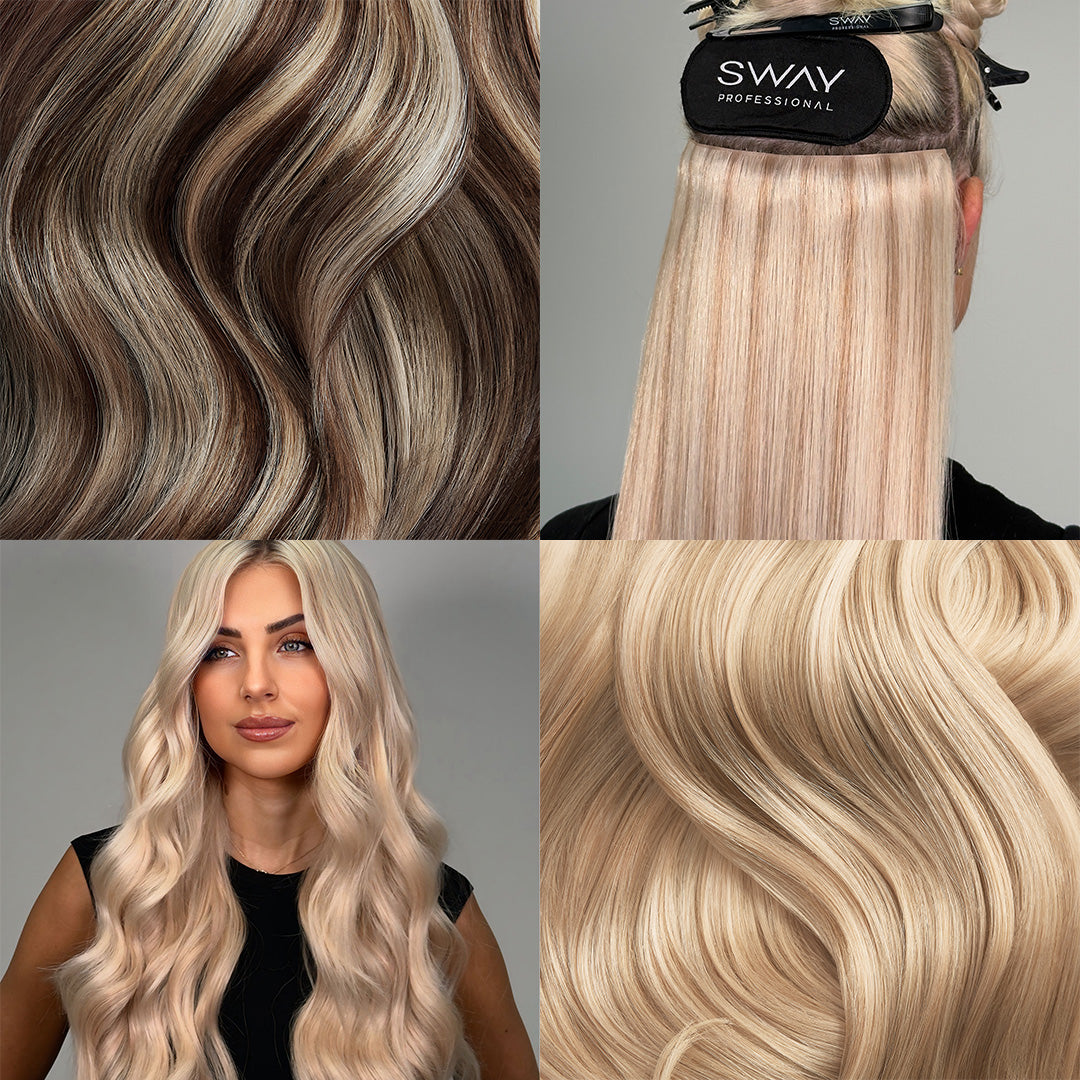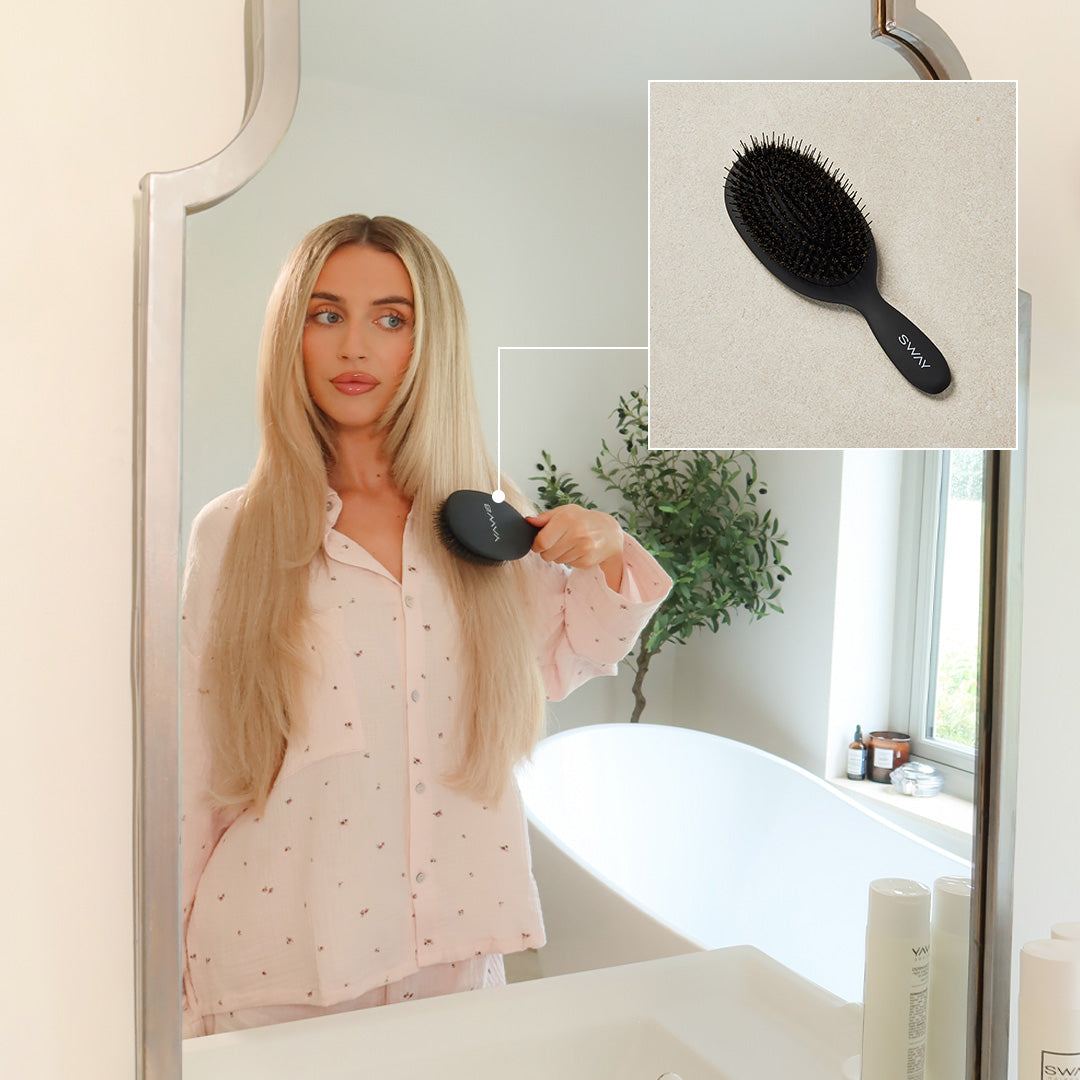At SWAY, we know there’s nothing quite like the feeling of freshly applied tape in extensions. That extra swish, that added volume, and the confidence that comes with flawless hair every day, it’s magic! However, we also know that all good things need a bit of maintenance.
We understand your schedule can become packed, making visits to the salon impractical at times. Our purpose is to guide you through every step of the process of learninghow to remove tape in extensions at home. So, let’s get started and take the stress out of saying goodbye to your current set of locks!
How to Remove Tape In Extensions: Tools/Products You'll Need
If you’re planning to remove your tape in extensions at home, you’ll want to make sure you have the right tools and products.
Keratin Remover
We’ve developed our own Keratin Remover specifically to take the stress out of removal. It’s gentle, effective, and made to protect both your natural hair and your extensions.
Removing tape ins might seem simple enough, but without the right product, it can quickly turn into a sticky situation. The adhesive used in our tape in extensions is designed to be strong and long-lasting. You’ll need something powerful enough to break down the bond while still being kind to your hair.
That’s where SWAY Keratin Remover comes in. It works fast to loosen the adhesive, making it easy to slide the tapes out without pulling or damaging your strands.
Pintail Comb
The Pintail Comb allows you to work through your hair with care. You'll be able to separate sections cleanly and tease apart the tapes without any unnecessary tension.
The fine metal tail is perfect for parting your hair into neat, manageable sections. That’s especially helpful if you’re working solo or dealing with a full head of extensions. You’ll be able to get to each tape bond easily without fumbling through tangled layers or guessing where one weft ends and another begins.
When it comes to removing the tapes, the fine teeth of the comb will help you gently lift the adhesive tabs once you’ve applied your remover.
Sectioning Clips
Removing tape ins isn’t something you want to rush. The key to doing it safely is being organised and working in neat, manageable sections. That’s exactly what sectioning clips help you do.
They keep your hair securely out of the way while you focus on removing one tape at a time. This prevents tangling or fumbling with stray strands.
Sectioning clips are strong, lightweight, and designed to hold all hair types. They have just the right amount of grip to stay in place without pulling or creasing your hair. You’ll be able to clip up the top layers, focus on the tapes underneath, and move smoothly from one section to the next.
How to Remove Tape In Extensions: Step-By-Step Removal
Whether you're getting ready for a fresh new set or giving your natural hair a little breather, using the right method makes all the difference. So, if you’ve never done it before (or even if you have), here’s your go-to guide on how to remove tape in extensions the SWAY way.
Step 1: Start with dry hair
Before anything else, make sure your hair is completely dry. Wet or damp hair can make removal more difficult and messy. Having dry hair will allow the remover to work its magic properly and makes separating the tapes far easier.
Step 2: Work in sections
Part your hair neatly so you can clearly see and access each tape bond. We recommend starting from the bottom layers and working your way up. Clip the rest of your hair out of the way so you have full control over the section you're working on.
Step 3: Apply keratin remover generously
Spray directly onto the tape tab, right where the two pieces of tape meet. Using enough remover helps break down the adhesive properly, meaning less effort and no damage. Let it soak in for around 30 seconds to a minute.
Step 4: Gently tease apart the tapes
Once the remover has had a moment to work, use your fingers or a Pintail Comb to gently separate the two wefts. If the tapes feel stuck or you meet any resistance, don’t force it. Simply apply more remover and wait a little longer.
Step 5: Slide out the extensions
Once the tape bond is broken down, the extension should slide away from your hair with ease. Place each one to the side so you can clean and reuse them later.
You may notice some shed hair stuck to the tape, but that’s completely normal. We naturally shed hair every day, and those strands just get caught in the adhesive while the extensions are in place.
Step 6: Repeat throughout your head
Continue section by section, always making sure each tape is properly saturated with remover before trying to take it out. Having a friend help with the back of your head can make things easier, but you can manage it solo with a mirror and a bit of patience.
Step 7: Clean up any residue
Once all your extensions are out, you might feel a bit of stickiness at your roots. Massage a bit of remover into the affected areas, then follow with Hydrating Shampoo to wash it out. Your hair will feel clean, refreshed, and free of any leftover adhesive.
Step 8: Treat your hair to some post-removal TLC
This is the perfect time to give your natural hair a good pamper. Apply a Hydrating Mask or deep conditioning treatment to nourish your strands after removal. A little love now will go a long way in keeping your hair healthy, shiny, and ready for your next set of tape ins.
Step 9: Reuse your extensions the smart way
One of the best things about SWAY tape in extensions is that they’re made to be reused. After removal, clean the tape area on each extension weft. Once they’re dry, simply apply new tape and you’re ready to go!
Aftercare for Natural Hair
After you remove your tape-in extensions, you should focus on restoring your natural hair. The removal process of extensions with adhesive has its challenges because it leaves residue that can dry out your hair.
Begin your hair care routine with deep cleansing to get rid any remaining adhesive or product buildup. Apply a hydrating shampoo to completely clean both your scalp and hair.
Pay attention to the areas with tape bonds because they tend to leave sticky residue. You may have to shampoo twice to remove any leftover oils that didn't come out the first time. Always apply a moisturising conditioner right after using a hydrating shampoo to achieve soft silky locks.
Follow up your routine with a deep conditioning or moisturising hair treatment. It's best to use a hydrating mask and leave it in for at least 5 minutes before rinsing.
This treatment will restore the softness of your hair, repair minor damage, and replenish moisture content that was lost when removing your extensions. It's best to choose hair products that have nourishing elements such as keratin, argan oil, or shea butter.
Common Mistakes to Avoid
When removing tape-in extensions at home, both patience and care are crucial for completing it successfully. You risk damaging your natural hair if you rush through or neglect essential steps in the process. We will highlight typical errors you should avoid and provide suggestions on how you can prevent them.
One problem women face is completing the process too quickly. Removing the extensions too quickly can lead to hair pulling, breakage, and leave adhesive residue on your hair strands. Allow the remover to work properly before moving forward and handle each section with caution.
Applying too much force when separating extensions or clearing away residue is another mistake to avoid. When you attempt to pull apart tape-in extensions before the adhesive breaks down completely, it will likely cause damage to your natural hair or put stress on your roots.
Not using conditioning treatments after removing your extensions can appear harmless, yet your hair is left vulnerable because your hair is stripped away of its natural oils and moisture. Your hair becomes brittle and dull and increases its susceptibility to breakage when you do not keep it hydrated. Hydrating masks are necessary to bring back both softness and strength to your hair.
Not removing the leftover adhesive could lead to issues later on. Leaving sticky residue on your hair or scalp will draw dirt, leading to tangling and prevents your extensions from holding. Wash your hair with hydrating shampoo and use a pintail comb to remove any leftover residue from your hair.
How to Remove Tape In Extensions: FAQs
1. Is it possible for me to take off tape-in extensions by myself at home?
Removing tape-in extensions at home is safe if you use proper tools and follow the correct steps. Using SWAY Keratin remover and practicing patience when removing your extensions is essential. Applying too much force or working too quickly when removing your extensions can leave your natural hair damaged. If you are unsure, we would always recommend seeking professional advice, and having a professional remove them.
2. What is the best remover to use on tape in extensions?
Keratin remover is specifically designed to take the stress out of removal. It’s gentle, effective, and made to protect both your natural hair and your extensions.
3. How long do I leave the remover on the tape before removing my extensions?
Keratin remover should stay on the tape for up to 30 seconds. Before pulling the tape apart, make sure to test whether the adhesive has loosened.
4. What should I do if the adhesive won’t come off my hair?
In case any residue is left after the initial treatment, reapply the remover and massage it into the sticky areas gently. Using a pintail comb makes it easier to remove any residual glue. After removing the residue, use a hydrating shampoo to clean your hair and scalp thoroughly.
5. Can I reuse my tape-in extensions?
Tape-in extensions can be used up to three times if they're in good condition. Before reinstalling your tape-in extensions, you should remove the old adhesive and apply new tape tabs. Keep your extensions in good condition by deep cleaning and storing them correctly after each use.




 Powered by
Powered by  – finance available up to 24 months
– finance available up to 24 months